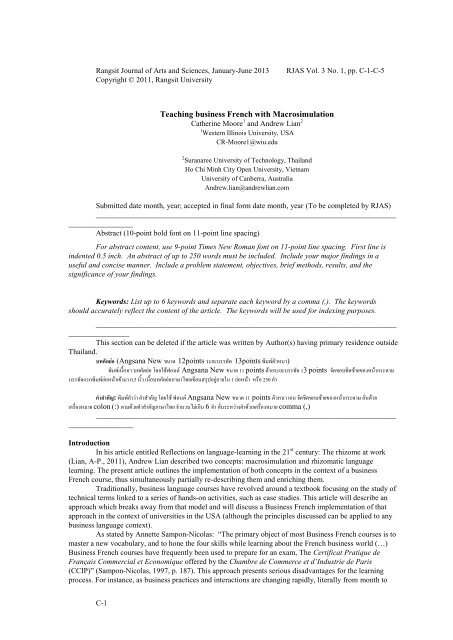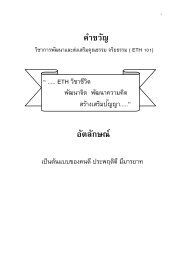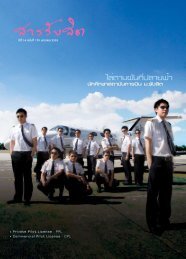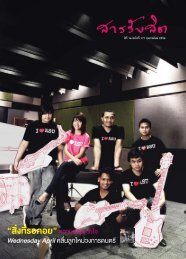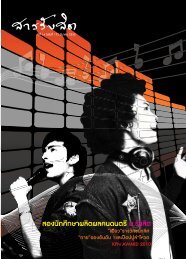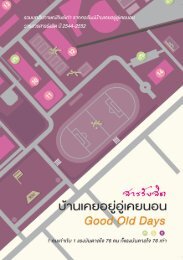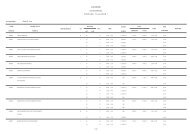Type Your Title Here Using Upper- and Lower-Case Letters
Type Your Title Here Using Upper- and Lower-Case Letters
Type Your Title Here Using Upper- and Lower-Case Letters
Create successful ePaper yourself
Turn your PDF publications into a flip-book with our unique Google optimized e-Paper software.
Even page header (To be completed by RJAS)month, the teacher must constantly update the material presented in the textbook <strong>and</strong>, although case studiesenable students to get a better underst<strong>and</strong>ing of cultural differences in the business world, other aspects oflanguage learning, e.g. communicative competence, are not fully supported. Furthermore, grammaticalaccuracy <strong>and</strong> other linguistic elements, such as pronunciation, intonation or body language are seldom partof business courses. Regrettably, they also fail to provide an overview of the diverse cultural practices ofthe Francophone world 1 as Business French courses have remained resolutely focused on France.In a modern pedagogic perspective where, at least according to some, learner knowledge isconstructed individually according to each person’s logical <strong>and</strong> representational systems (e.g. Lian 2004, p.3), the challenge facing business language specialists will be to develop the above missing elements. It willalso involve positioning the students at the heart of the learning process. This is to counter practices intraditional business courses where the teacher, more than in other courses, is perceived as the holder of atechnical somewhat esoteric knowledge <strong>and</strong> occupies center stage, thus leaving little room for learners’individual expression <strong>and</strong> personal contributions. In addition, studies have clearly indicated that, in order torespond to the dem<strong>and</strong>s of the international marketplace, <strong>and</strong> in particular, of French-owned companies inthe United States, “we need to prepare our students better by emphasizing oral communication, <strong>and</strong> thereading <strong>and</strong> writing of authentic documents” (Sampon-Nicolas 1997). A similar finding was documentedin ‘Foreign Languages <strong>and</strong> International Business: Meeting the Dem<strong>and</strong>s of the 90s’ (Moore <strong>and</strong> McGoey,1995a). The solution proposed at the time was to assign students extensive research projects on the Web sothat they could “learn about employment opportunities, study economic developments […] while usingtheir newly acquired French business terms in authentic settings” (Sampon-Nicolas, 1997, p. 187). Morethan ten years later the situation has not changed much <strong>and</strong> the need for developing innovative teachingapproaches is even stronger.Keeping the above in mind, our article seeks to offer an original perspective on this area oflanguage study which is gaining importance <strong>and</strong> popularity because of its practicality. Our goal is, ideally,to remodel the concept of Business French courses so as to make them properly learner-centered. In order toachieve this, we suggest, as a point of departure, a learning structure that has already been used for generallanguage courses: ongoing self-managed macrosimulation (cf. Lian, A-P. & Mestre, 1985; <strong>and</strong> alsosimulation globale, a variation on the same idea developed a decade later, Yaiche, 1996).Introduction to macrosimulationA macrosimulation is a long-term simulation where participants are required to create a specificlifelike environment—such as a village, a college campus, a school. They build houses <strong>and</strong> other buildingsconsistent with the foreign environment, generate local institutions <strong>and</strong> develop local ways of life. Theyselect roles <strong>and</strong> personae, determine their characters <strong>and</strong> act out their roles for significant periods of timee.g. a whole semester. The simulation develops naturally according to the students’ interactions providedthat they conform to the specific cultural constraints of the situations that they have chosen to act out. As anexample, if the simulation occurs in a French village, then behaviors <strong>and</strong> interactions appropriate to aFrench village will be expected. In other words, the simulation is totally under the control of the studentsbut there are cultural <strong>and</strong> linguistic constraints to respect (this may not always happen immediately as thesimulation itself serves to introduce <strong>and</strong> raise awareness of appropriate cultural <strong>and</strong> linguistic knowledge. Inthe beginning such knowledge will simply not be there). Over time, participants develop a sense of theirown history within the simulation <strong>and</strong> their personal stakes change: they are no longer just doing anexercise as their “self” is at risk, just as in real life. They now have something real to lose: their self. Theirinteractions in the simulation are video-recorded <strong>and</strong> time is set aside for observation <strong>and</strong> analysis of theirperformances by teachers, other students, even the general public (adapted from Lian, A-P., 2004; cf. alsoLian, A-P., 2011; Lian & Mestre, 1985; Mestre & Lian, 1983). Feedback from the analysis suggests futurelearning activities <strong>and</strong> usually generates a learning plan potentially involving all kinds of work such asindividualized pronunciation lessons, listening comprehension exercises, familiarization with language <strong>and</strong>1 Such is the case of Québec : « La province, qui entretient avec les Etats-Unis, des échanges économiques plusimportants que la France, est à toutes fins utiles absentes des contenus des cours de français de spécialité » (Fontenay,1997). The same is true of the Francophone countries of Africa.C-2
RJAS Vol. 3 No. 1 Jan.-Jun. 2013, pp. C-1-C-5As a general principle, the first step of a macrosimulation involves each student deciding on therole they wish to play out. Each role, in turn, is connected to a large number of potential activities.Students organize their “lives” by defining the tasks at h<strong>and</strong>, doing research by consulting authenticdocuments available on their database or on the Web, preparing the different stages of the simulation <strong>and</strong>acting them out. Each activity creates a new focus for reflection as well as a raft of new activities. Theprocess is open-ended, more or less infinite in its possibilities <strong>and</strong> lends itself to all kinds of teachingstructures, both traditional <strong>and</strong> non-traditional: a one semester or two semester course, a refresher course forprofessionals, an intensive summer course, a short course. Students may be language majors or businessmajors (perhaps minoring in languages), business people or, for that matter, language teachers. To ensurerapid development of activities <strong>and</strong> interaction, students probably need to have completed at least anintermediate level course in the target language. Ideally, they should be somewhat autonomous <strong>and</strong> selfmotivated,as they will be directly involved in <strong>and</strong> responsible for their learning process although themacrosimulation itself automatically encourages autonomy development. Teachers act more as conductors<strong>and</strong> guide, they advise the students, provide suggestions <strong>and</strong> feedback, supply research tools, correctmistakes, comment on discussions choices. In short, they intervene when needed, but are no longer thefocus of class attention.We will, now examine in some detail four essential (<strong>and</strong>, to that extent, predictable) stages in ourbusiness macrosimulation: initiation of role assignment, job advertisements, the c<strong>and</strong>idate’s portfolio <strong>and</strong>job interview, <strong>and</strong> we will identify the kinds of activities suitable for each stage.While this sequencing may seem imposed, <strong>and</strong> therefore in contradiction with the spirit ofmacrosimulation which is directed by organic development of the simulation, in reality, in the Frenchcontext, this sequence of steps is, with few exceptions, conventionally predetermined <strong>and</strong> m<strong>and</strong>atory forsuccess.1. Role assignment <strong>and</strong> initiation of role play: listening, speaking, reading, writing, culturalawarenessThe first task for students is to choose a role for themselves e.g. job-seeker, employer, employee,advisor, consultant, office administrator, etc. As their roles <strong>and</strong> the simulation evolve, students may findthemselves becoming the employer rather than the job-seeker, an office administrator rather than anemployee according to circumstances. Besides the three main roles of counselor, job-seeker <strong>and</strong> recruiter,many other roles are available: friends, family members, business <strong>and</strong> personal contacts, referees such asformer employers or teachers, alumni associations, secretaries, receptionists, director of human resources,etc. Students are able to select from several different protagonists thus setting up a variety of formal <strong>and</strong>informal interactions.At the beginning of the mascrosimulation, students are asked how they imagine job-seeking <strong>and</strong>the employment culture in France. The teacher then analyzes <strong>and</strong> discusses students’ underst<strong>and</strong>ings <strong>and</strong>possible misconceptions. Cultural differences will impact heavily on the role play.In France, the largest recruiter is the public sector, or fonction publique. This is considered themost desirable employer owing to job security. Unemployment is high among young graduates with nowork experience, <strong>and</strong> well paid secure jobs (or CDI Contrats à Durée indéterminée) are very hard to comeby. A job search is, therefore, a long, extremely competitive process which is often very stressful. Mostyoung people are forced to accept a string of low paid internships or CDD (Contrats à durée determine -short term contracts) before l<strong>and</strong>ing their dream job, or any job for that matter. Many job-seekers have torely on piston (connections) just to get an interview. While formal qualifications are extremely importantthroughout one’s career, increasingly, job-seekers have to settle for jobs that are below their level ofeducation <strong>and</strong> offer little or no security.Before playing their parts, students preview short videos so as to clearly identify obviousdifferences between French <strong>and</strong> American general appearance <strong>and</strong> behavior. They study posture <strong>and</strong> bodylanguage as well as other physical characteristics. They notice, for instance, that professional relationshipsare extremely formal while the dress code is somewhat different from the American “interview suit” <strong>and</strong>,paradoxically, is often more relaxed. They discover that h<strong>and</strong>shaking is compulsory (<strong>and</strong> different from itsAmerican counterpart) when meeting someone <strong>and</strong>, that h<strong>and</strong>shakes may be seen as revealing aspects of theC-5
RJAS Vol. 3 No. 1 Jan.-Jun. 2013, pp. C-1-C-5to invite c<strong>and</strong>idates for interviewto respond to an interview invitationto set up a date, time <strong>and</strong> place for the interviewAfter listening to sample telephone conversations, students begin to grow an awareness ofidiomatic expressions <strong>and</strong> basic professional interaction rules such as: how to be welcoming, polite, clear,articulate <strong>and</strong> concise, when <strong>and</strong> how to repeat key information, <strong>and</strong> the obligation to remember greetings<strong>and</strong> farewell formulae. Emails are often used for first contacts. Although less formal than the cover letter,French emails tend to be more intricate, courteous <strong>and</strong> formal than American emails.Job interviewThe second most important step in job-seeking is the job interview. Job-seekers need to preparecarefully before facing the recruiters. The Web offers a wealth of tools including advice on how to tackleinterviews <strong>and</strong> tricky situations. It also offers sample illustrative videos made available through thedatabase <strong>and</strong> is organized <strong>and</strong> commented upon by experienced (<strong>and</strong> sometimes inexperienced) languageusers <strong>and</strong> employment professionals (principally from outside the simulation) through one or more socialnetworks.Students watch informational videos advising job-seekers on such things as what to do, how todress, what to say, how to behave, how to respond, how to deal with difficult questions. As an exercise,they make lists of things to do <strong>and</strong> things to avoid, <strong>and</strong> draft possible answers to challenging questions.Then, they preview job interview videos available through the web or the database. They analyze them,critique them, keep the best, <strong>and</strong> then create their own interview, act it out <strong>and</strong> film themselves.Personal videos are viewed <strong>and</strong> critiqued in class <strong>and</strong> through social professional networksprovided by the IT infrastructure. Drawing on diverse forms of assistance, students then identify ways toimprove on their initial performance. While “perfection” is not required, the process should nonethelesslead to a better underst<strong>and</strong>ing of what constitutes a “good” job interview.Interview videos accessed through the IT infrastructure provide students with key information oncultural differences relating to dress, attitude, <strong>and</strong> also language while feedback from peers, teachers <strong>and</strong>professional people through social <strong>and</strong> professional networks (online <strong>and</strong> personal) will refine the students’personal discoveries. As a consequence, students will learn that French interview techniques can beharsher than in the United States. For instance, it is common practice to ask questions deliberately designedto destabilize c<strong>and</strong>idates just to gauge how they will respond. Furthermore, job-seekers are ofteninterviewed in several languages besides their native tongue. As an exercise, students are taught toimagine typical “throw-off” questions, possible reactions to them as well as techniques for countering them.More activities can be envisioned such as meeting with the counselor following the interview,dealing with a telephone call from the Human Resources department offering employment, negotiatingfuture salary <strong>and</strong> benefits, writing a letter of acceptance, attending an orientation meeting at the new placeof employment, etc.As we can see, the macrosimulation can go on forever <strong>and</strong> could take two or even more semestersto complete. As the students live through the simulation they gradually gain an awareness of the mainaspects of the French Business world. Students then compare the entire hiring process in the United States<strong>and</strong> Francophone countries <strong>and</strong> outline cultural <strong>and</strong> other misunderst<strong>and</strong>ings that may arise when crossingfrom one culture to the other. This of course is the ultimate goal of this approach.ConclusionIn this paper we have sought to share a learning framework based on a concept of personalknowledge-construction which challenges the notion of lock-stepped synchrony of learning activitiesorchestrated by a teacher or textbook. Instead, it replaces the arbitrary sequencing of activities with adynamic, student-directed, technology-supported learning network which is open, negotiable <strong>and</strong>negotiated, highly task-oriented <strong>and</strong> resource-based offering students the possibility toprogress at their own pace in unpredicted <strong>and</strong> unpredictable directions through knowledgerepresentationnetworks in a relatively asynchronous fashion as determined, effectively, by theirpersonal needs <strong>and</strong> histories (adapted in part from Lian, 1987).C-9
RJAS Vol. 3 No. 1 Jan.-Jun. 2013, pp. C-1-C-5Swender, E., Conrad, D., & Vicars, R. (2012). ACTFL proficiency guidelines 2012. (3rd ed.). Alex<strong>and</strong>ria,VA: American Council for the Teaching of Foreign Languages. Retrieved fromhttp://actflproficiencyguidelines2012.org/Wood, A. (2002). Sigles for Success: Acronyms in the Business French Class. The Journal of language forInternational business, 13(1), 1-10.Yaiche, F. (1996). Les simulations globales, Paris: Hachette.C-11


